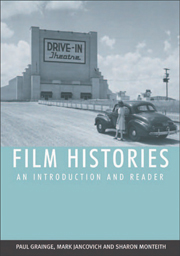Book contents
- Frontmatter
- Contents
- Preface
- Part I Film History from its Origins to 1945
- Part II Film History from 1946 to the Present
- 13 Postwar Challenges: National Regeneration, HUAC Investigations, Divestiture and Declining Audiences
- 14 The Politics of Polarisation: Affluence, Anxiety and the Cold War
- 15 Cinematic Spectacles and the Rise of the Independents
- 16 New Waves, Specialist Audiences and Adult Films
- 17 Radicalism, Revolution and Counter-Cinema
- 18 Modernism, Nostalgia and the Hollywood Renaissance
- 19 From Movie Brats to Movie Blockbusters
- 20 The Exhibitors Strike Back: Multiplexes, Video and the Rise of Home Cinema
- 21 Postmodernism, High Concept and Eighties Excess
- 22 Cults, Independents and ‘Guerrilla’ Filmmaking
- 23 From Cinemas to Theme Parks: Conglomeration, Synergy and Multimedia
- 24 Globalisation and the New Millennium
- Bibliography
- Copyright Acknowledgements
- Index
14 - The Politics of Polarisation: Affluence, Anxiety and the Cold War
from Part II - Film History from 1946 to the Present
Published online by Cambridge University Press: 05 August 2013
- Frontmatter
- Contents
- Preface
- Part I Film History from its Origins to 1945
- Part II Film History from 1946 to the Present
- 13 Postwar Challenges: National Regeneration, HUAC Investigations, Divestiture and Declining Audiences
- 14 The Politics of Polarisation: Affluence, Anxiety and the Cold War
- 15 Cinematic Spectacles and the Rise of the Independents
- 16 New Waves, Specialist Audiences and Adult Films
- 17 Radicalism, Revolution and Counter-Cinema
- 18 Modernism, Nostalgia and the Hollywood Renaissance
- 19 From Movie Brats to Movie Blockbusters
- 20 The Exhibitors Strike Back: Multiplexes, Video and the Rise of Home Cinema
- 21 Postmodernism, High Concept and Eighties Excess
- 22 Cults, Independents and ‘Guerrilla’ Filmmaking
- 23 From Cinemas to Theme Parks: Conglomeration, Synergy and Multimedia
- 24 Globalisation and the New Millennium
- Bibliography
- Copyright Acknowledgements
- Index
Summary
The 1950s was a decade of contradictions in society as well as cinema, a decade in which ideals such as a middle-class lifestyle, the model home, and marriage and parenthood were complicated and undermined by anxieties over gender roles and cross-generational tensions. The nuclear family ideal was of particular importance in the postwar period as a site of hope and regeneration. For example, Marty starring Ernest Borgnine was originally a television play but in 1955 it was the Academy's surprise choice for Best Picture. The story of the young man whose loyalty to his elderly mother slowly gives way to love and marriage in a new neighbourhood successfully tapped into a postwar ideology that linked marriage and family with civic virtues. In fact, in 1954 Life magazine aired a special feature on the ‘domestication’ of the American male. However, the rise of suburbia as a phenomenon in the 1950s also meant that middle-class wives expected to stay at home felt ‘lost’ in the suburbs while husbands commuted to the office. The consumer trap put pressure on both men and women to ensure that the home and family would remain perfect – even as children became teenagers in the 1950s. Out of the so-called era of conformity, there emerged an exciting cinema, with films often made by maverick outsiders, such as William Castle, Orson Welles and Roger Corman, outsiders who would come to dominate as independent directors by the end of the decade.
- Type
- Chapter
- Information
- Film HistoriesAn Introduction and Reader, pp. 305 - 339Publisher: Edinburgh University PressPrint publication year: 2007



